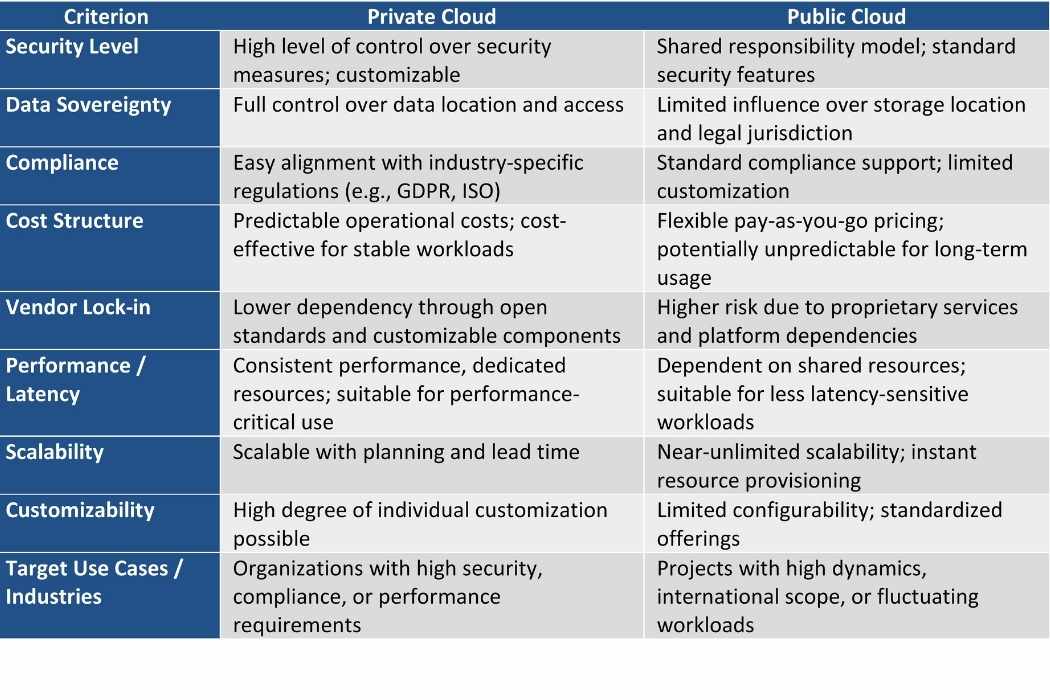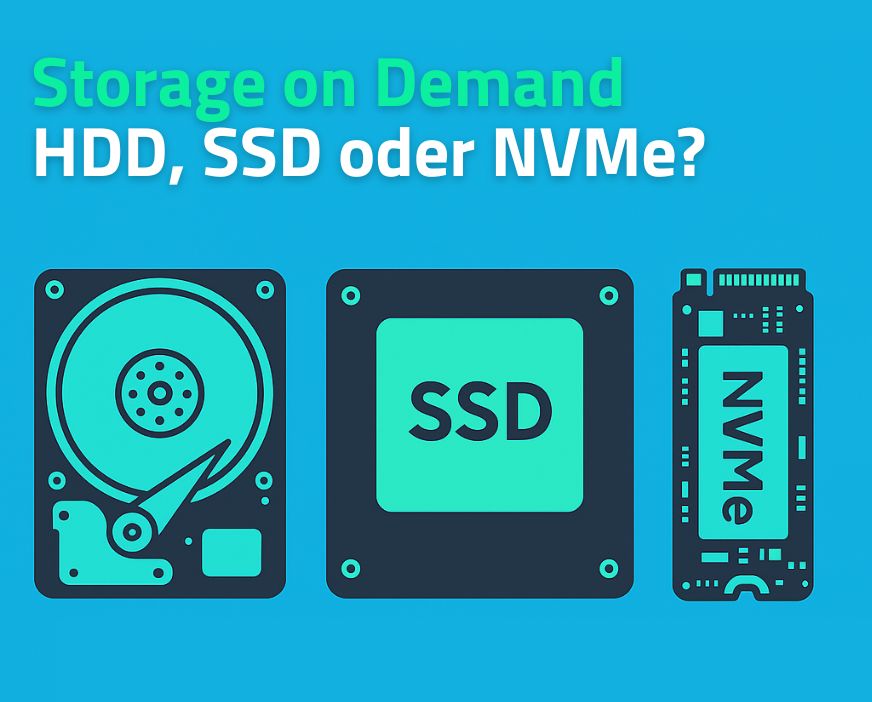Companies looking to outsource their IT infrastructure to the cloud face a fundamental decision: Public Cloud or Private Cloud? Both models have different advantages. And both have their own requirements for security, flexibility, and cost control. While the Public Cloud is designed for maximum scalability and rapid deployment, the Private Cloud excels with maximum control and customizability. Which solution is more suitable depends on the framework conditions and requirements of the respective company.
Two Models, Two Philosophies
The Public Cloud is based on the principle of shared resources: Multiple customers access a common, standardized infrastructure operated by large and well-known providers (hyperscalers) such as Amazon (AWS), Microsoft (Azure), or Google. This model is cost-efficient, easily scalable, and particularly suitable for variable or short-term loads. The Private Cloud, on the other hand, offers dedicated resources exclusively available to one company: either in its own data center or with a specialized provider. It allows for finer control of systems, offers higher security, and can be specifically tailored to individual compliance or performance requirements.
Security: Control vs. Shared Responsibility
Security is a central aspect when considering Public Cloud or Private Cloud. In the Private Cloud, control over infrastructure, data flows, and access rights lies entirely with the company itself or with the commissioned service provider. This allows for individually designed security measures, such as the integration of special firewalls or role-based access concepts. Especially for industries with increased regulatory requirements (e.g., healthcare, financial sector, or public service), the Private Cloud can significantly facilitate compliance with regulations such as GDPR, ISO 27001, or industry-specific standards.
The Public Cloud follows the principle of Shared Responsibility: The provider secures the physical infrastructure and cloud operations, while the customer remains responsible for the security of their applications, accesses, and data. While hyperscalers invest massively in cybersecurity, standardized environments and shared resources come with risks. These include potential misconfigurations, complex access structures, or inability to influence data storage location. Individual security concepts can also only be implemented to a limited extent. This makes it difficult to adapt to company-specific policies.
Data Sovereignty and Digital Sovereignty
An important decision factor in many companies’ cloud strategy today is the question of data sovereignty: the control over where data is stored, who can access it, and which legal frameworks apply to it. In the Private Cloud, companies retain this control to a much greater extent. If it’s a provider from the European region that uses open-source software, companies retain full sovereignty over their data and do not risk losing their intellectual property such as trade or business secrets (also read a comment on the incompatibility of GDPR and CLOUD Act). The physical location of the data can be clearly defined, for example in a specific data center in Germany or the EU. This not only facilitates compliance with GDPR but also creates transparency regarding access rights and regulatory requirements.
With the Public Cloud, however, data sovereignty is not guaranteed when providers operate globally, store data in distributed data centers, and are subject to non-European legal systems such as the US CLOUD Act. Even if a data center is located in Europe, access authorizations from abroad cannot be completely ruled out. For any company that relies on digital sovereignty and legal clarity, this poses a risk. Especially in sensitive areas such as government agencies, research, or critical infrastructure, the Private Cloud should be considered the preferred option.
Jerome Evans, founder and CEO of firstcolo GmbH, on the differences between the two cloud models:
When it comes to IT outsourcing and secure data storage and transmission, the private cloud is one of the strongest alternatives. Here, a single user receives all available computing resources. This gives them far more control over the infrastructure and the ability to customize it individually. Security requirements and regulatory compliance are easily met.
A public cloud, on the other hand, is much more rigid because the infrastructure is always available to multiple users. This results in significantly less individuality. It is often impossible to determine the data location, which makes compliance with GDPR standards more difficult, for example. In addition to security, performance and cost structure are also decisive factors for using a private cloud. Especially for data-driven workloads such as machine learning or virtual desktop infrastructures, minimal latencies and high performance are basic requirements.
These requirements can be met much better with on-premise deployment or in private clouds, as the infrastructure can be designed to a greater extent. In a private cloud, the hardware components used are also precisely tailored to the user. This means that no unnecessary additional costs are incurred. Especially for long-term operated infrastructure, this results in a better overall cost structure than many alternatives.
Costs, Performance, and Dependencies
The cost structure of public and private clouds differs fundamentally. The public cloud typically uses usage-based billing models (“Pay as you go”), which is particularly attractive for dynamically growing or short-term projects. Companies can scale resources flexibly and only pay for actually used capacities. However, this flexibility can also lead to a lack of transparency or costs that are difficult to calculate, especially with permanently high loads or complex workloads. In addition, there is often a technological dependency on the respective provider: Proprietary services, interfaces, and management tools make it difficult to switch providers. This calculated forced commitment to the provider is part of the hyperscalers’ business model (vendor lock-in).
The private cloud usually follows a different model: Resources are provided dedicatedly, which leads to better cost control, especially in stable or long-term plannable scenarios. Initial investments and operating costs are higher, but are often more economically advantageous with appropriate utilization. Moreover, open-source technologies and standardized interfaces can be used, so companies do not have to depend on individual providers. Performance is also more predictable in the private cloud: As no shared resources are used, it provides low latencies, constant performance, and targeted resource distribution. This is necessary, for example, for computationally intensive applications such as AI models.
In terms of scalability, the public cloud scores with almost unlimited resources that can be booked in real-time: A big advantage for load peaks (e.g., discount promotions of an e-commerce provider) or internationally distributed applications. The private cloud also offers scalability, albeit within a narrower framework: New resources must be provided physically or by the provider. This requires more planning effort, but at the same time allows for a higher degree of control.

Whether public cloud or private cloud depends on the usage context
The choice of the right cloud model should always be based on the individual requirements, security needs, and overall objectives of a company. With its high scalability, rapid deployment, and usage-based billing, the public cloud is particularly attractive for dynamic, internationally oriented, or short-term projects. The private cloud, on the other hand, offers advantages in terms of control, data sovereignty, customizability, and long-term cost planning.
Especially in regulated industries, with sensitive data or business-critical applications, a private cloud can provide the necessary security and compliance. These are more difficult to achieve in standardized public cloud environments. At the same time, the two models are by no means mutually exclusive: Hybrid cloud and multi-cloud strategies are gaining in importance to combine their respective strengths in a targeted manner.
Companies should therefore not decide solely on the basis of short-term costs or technical feasibility. Rather, they should evaluate their cloud strategy in the context of long-term IT strategies, regulatory requirements, and digital independence.

About Jerome Evans
Jerome Evans is the founder and managing director of firstcolo GmbH. For about 20 years, he has been involved with IT services and the construction and operation of data centers and cloud-based server infrastructures.







